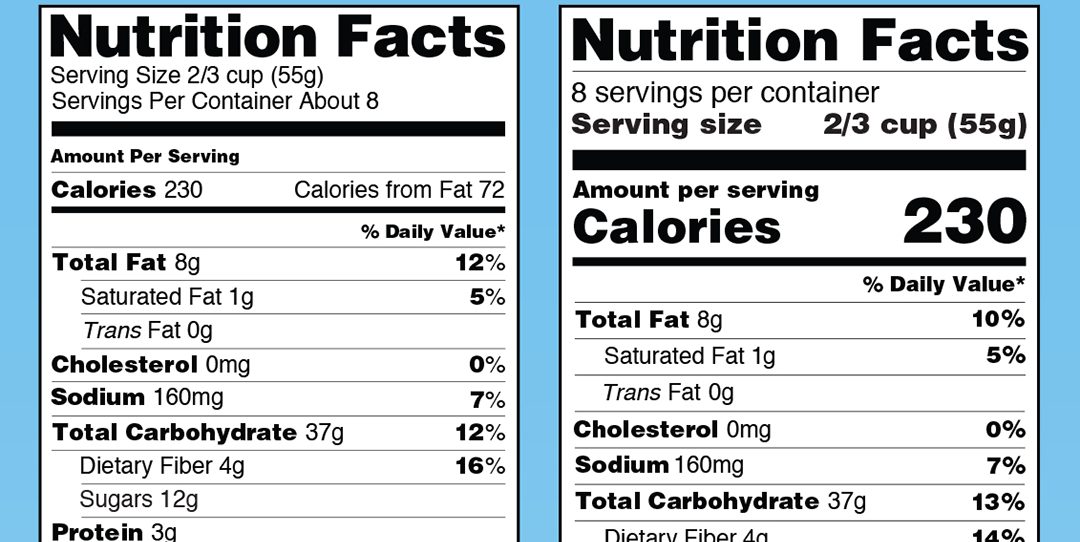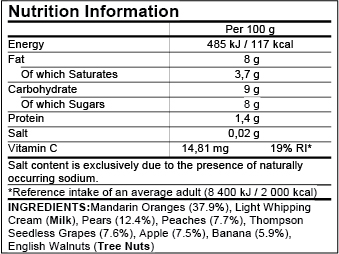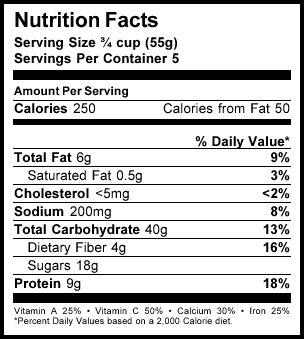41 nutrition labels list the energy content of food in
How to Use the Nutrition Facts Label - Diet Doctor Again, the calculation is very simple: 1. Check the serving size. The nutrition facts label always has both "Serving size" and "Servings per container/package" listed at the top. If you're holding a snack pack that looks like it's one serving, don't assume that the nutrition values listed are for the entire bag. Nutrition Labels 101: What's Required? What's Optional? Total carbohydrates is a required listing unless there is less than 1 gram, at which point it can be expressed as "contains less than 1 gram," or if less than 0.5 grams per serving, it can be expressed as zero. Sugars are the sneaky nutrient found naturally in many "healthy" foods, including fruit and milk.
Nutrition Facts Label | Healthy Schools | CDC Nutrition Facts Label. ... Content source: Division of Population Health, National Center for Chronic Disease Prevention and Health Promotion. home CDC Healthy Schools. About CDC Healthy Schools plus icon. ... Food Allergies in Schools Toolkit; Obesity plus icon. Youth Obesity Maps (2003-2019) Body Mass Index (BMI) Measurement in Schools ...

Nutrition labels list the energy content of food in
Food Labels Guide & Examples | How to Read Nutrition Labels - Study.com A nutrition facts label, or food label, is designed to provide information about the nutrient content of the food item. At the top we find the 'Serving Size' and 'Servings Per Container,' followed ... How to calculate the Energy available from foods - Time-to-Run To calculate the energy available from a food, multiply the number of grams of carbohydrate, protein, and fat by 4,4, and 9, respectively. Then add the results together. For example, 1 slice of bread with a tablespoon of peanut butter on it contains 16 grams carbohydrate, 7 grams protein, and 9 grams fat : 16g carbohydrate x 4 kcal/g = 64 kca l. Nutrition facts label - Wikipedia The nutrition facts label (also known as the nutrition information panel, and other slight variations) is a label required on most packaged food in many countries, showing what nutrients and other ingredients (to limit and get enough of) are in the food. Labels are usually based on official nutritional rating systems.Most countries also release overall nutrition guides for general educational ...
Nutrition labels list the energy content of food in. Chapter 3: Calculation of The Energy Content of Foods - Energy ... The value for carbohydrate energy in chocolate is an extreme example - the factors range from 5.56 kJ/g (1.33 kcal/g) to 17 kJ/g (4.0 kcal/g). For most individual foods that are major sources of energy in the diet, use of a specific rather than a general factor results in differences that range from -6 to +3 percent. Food Labels | Nutrition.gov What's New with the Nutrition Facts Label. HHS, Food and Drug Administration. The U.S. Food and Drug Administration (FDA) has updated the Nutrition Facts label on packaged foods and beverages with a fresh design that will make it easier for you to make informed food choices that contribute to lifelong healthy eating habits. What's in a Name? Calories on the New Nutrition Facts Label | FDA 2,000 calories a day is used as a general guide for nutrition advice, but your calorie needs may be higher or lower depending on your age, sex, height, weight, and physical activity level. Eating ... Understanding Food Nutrition Labels - American Heart Association Remember that the information shown in the label is based on a diet of 2,000 calories a day. You may need less or more than 2,000 calories depending upon your age, gender, activity level, and whether you're trying to lose, gain or maintain your weight. When the Nutrition Facts label says a food contains "0 g" of trans fat, but includes ...
Nutrition Labels Flashcards | Quizlet A list of percentages that compares how much of a certain nutrient one serving of food contains to how much of that nutrient you should consume daily. Sodium. Dietary Guidelines for Americans recommend that you consume less than 2,300 milligrams (mg) of per day. Bad for you Fats. Trans Fat, Saturated Fat. Cholesterol. Food Labels: Carbohydrates | Home & Garden Information Center According to nutrition experts, carbohydrates should provide 45-65% of your total daily calories. That means carbohydrates should supply 900 calories or more in a 2,000-calorie-a-day diet. Facts on Food Labels. Food labels contain clues to a food's carbohydrate content, including the amount per serving. Food labels - NHS Nutrition labels on the front of packaging. Most of the big supermarkets and many food manufacturers also display nutritional information on the front of pre-packed food. This is very useful when you want to compare different food products at a glance. Front-of-pack labels usually give a quick guide to: energy; fat content; saturated fat content Understanding Food Labels | The Nutrition Source | Harvard T.H. Chan ... These statements describe the nutrients in a food beyond what is listed on the Nutrition Facts label, intended to showcase a health benefit of the food. An example is "Contains 100% Vitamin C.". Most terms like "low sodium," "high fiber," "reduced fat," and "good source of" are regulated by the FDA, and the nutrient amounts ...
Nutritional Values For Common Foods And Products Please consult with your doctor before making any changes to your diet. Nutrition labels presented on this site is for illustration purposes only. Food images may show a similar or a related product and are not meant to be used for food identification. Nutritional value of a cooked product is provided for the given weight of cooked food. Why Do Food Labels Use Calories Instead of Joules or Kilojoules? The Atwater system is generally used by the food industry for U.S. labels. This is a standard for calculating the energy value of carbohydrates, fats and proteins. These kilocalories are expressed as "calories." The system assigns 4 calories per gram to carbohydrates, 9 calories per gram to fats and 4 calories per gram to proteins. How to Understand and Use the Nutrition Facts Label | FDA It's important to realize that all the nutrient amounts shown on the label, including the number of calories, refer to the size of the serving. Pay attention to the serving size, especially how ... Nutrient food labels Flashcards | Quizlet Start studying Nutrient food labels. Learn vocabulary, terms, and more with flashcards, games, and other study tools. Home Browse. ... •Total food energy; food energy from fat •Total fat; saturated fat; trans fat; cholesterol ... Nutrition 2.1 Food Labels. 42 terms. Diana_Lopez0920. health claims and food labels. 50 terms. sydneyfinder.
Learn How the Nutrition Facts Label Can Help You Improve Your Health The Nutrition Facts label on packaged foods is based on updated science and dietary recommendations for Americans. Using the label can help you choose foods for a healthy diet. The label is required on all packaged foods made in the United States and imported from other countries. The US Food and Drug Administration (FDA) issued regulations in ...
Nutrition Labelling - Centre for Food Safety - Home Nutrition label must include the information on energy and seven nutrients specified for labelling (1+7), namely, protein, carbohydrates, total fat, saturated fatty acids, trans fatty acids, sodium and sugars. Furthermore, the nutrition label must list the amounts of any claimed nutrients. In case where there is a nutrition claim in relation to ...
Nutrition information panels - Food Standards Nutrition information panels (NIP) on food labels provide information on the average quantity of energy in kilojoules or in kilojoules and kilocalories and these nutrients: sodium - a component of salt. A NIP will include information about other nutrients if a claim is made. For example, if a food has a 'good source of fibre' claim then the ...
How Do You Know Your Food's Nutrition Facts Label Is Accurate? The short answer. Manufacturers often confirm their nutrition numbers by matching their products as closely as possible to NIST's food reference materials, which contain precisely measured quantities of nutrients. NIST's measurements are accurate to within 2% to 5% for nutrient elements (such as sodium, calcium and potassium ...
How to understand food labels - Eat For Health Sometimes labels will include nutrition content claims like 'low fat', 'reduced salt' or 'high fibre'. These claims can only be used if the food meets certain criteria. For example, with a 'good source of calcium' claim, the food must contain more than a set amount of calcium. While nutrition content claims can generally guide ...
What are Nutrient Content Claims on food labels ... - Nutritionist Pro™ Nutrient Content Claims on Food Panels. List energy, fat, carbohydrates, protein, and sodium. The nutritional information panels are a better guide than advertising. If the product contains food-inducing allergens, the label must say so. Some of the healthiest foods don't have labels, including fresh fruit and vegetables, and fish.
Nutrition labelling | Food Standards Agency Mandatory information. When providing nutrition information, you are required to declare: energy value. amounts of fat, saturates, carbohydrate, sugars, protein and salt. The content of the mandatory nutrition declaration can be supplemented with an indication of the amounts of one or more of the following: monounsaturates.
Energy in Food and Nutrition | Chemistry for Non-Majors - Course Hero Energy from Protein: 5 g x 4 kcal/g = 20 kcal = 20 Cal. Convert to kJ. 20 Cal x 4.184kJ/Cal = 83.68 kJ = 84 kJ. Step 3: Think about your result . For the snack food in this example, most of the energy is coming from fat first, then from carbohydrates and finally from protein when these three sources of energy are considered.





Post a Comment for "41 nutrition labels list the energy content of food in"